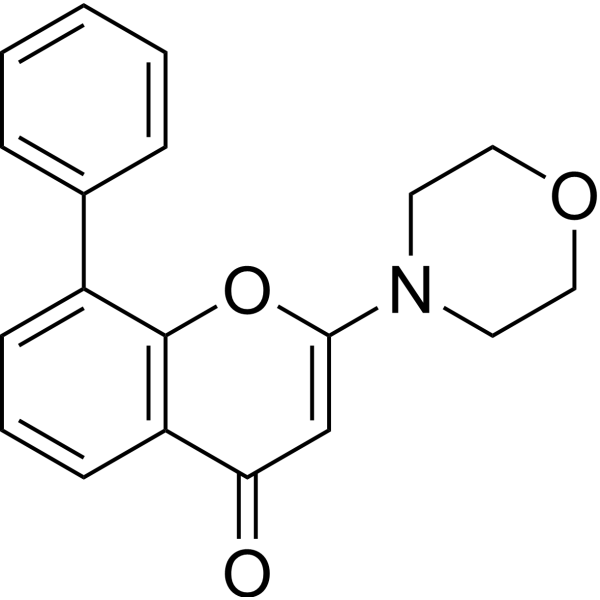Home
Products
LY294002



| Product Name | LY294002 |
| Price: | Inquiry |
| Catalog No.: | CN00550 |
| CAS No.: | 154447-36-6 |
| Molecular Formula: | C19H17NO3 |
| Molecular Weight: | 307.34 g/mol |
| Purity: | >=98% |
| Type of Compound: | Alkaloids |
| Physical Desc.: | Powder |
| Source: | |
| Solvent: | Chloroform, Dichloromethane, Ethyl Acetate, DMSO, Acetone, etc. |
| SMILES: | O=c1cc(oc2c1cccc2c1ccccc1)N1CCOCC1 |
| Contact us | |
|---|---|
| First Name: | |
| Last Name: | |
| E-mail: | |
| Question: | |
| Description | LY294002 is a broad-spectrum inhibitor of PI3K with IC50s of 0.5, 0.57, and 0.97 μM for PI3Kα, PI3Kδ and PI3Kβ, respectively. It also inhibits CK2 with an IC50 of 98 nM. |
| Target | p110α:0.5 μM (IC50) p110δ:0.57 μM (IC50) p110β:0.97 μM (IC50) CK2:98 nM (IC50) Autophagy |
| In Vitro | LY294002 (5 μM) completely inhibits the phosphorylation of PKB In HepG2 cells. LY294002 (5 μM) is also shown to block insulin-induced phosphorylation of PKB Ser473 in CHO-IR cells[1]. LY294002 is also a potent inhibitor of CK2 (casein kinase 2) with IC50 of 98 nM. LY294002 is also able to reduce the kinase activity of both isoforms of the serine/threonine kinases GSK3α and β[2]. When the CNE-2Z cell line is cultured in medium containing LY294002(0 μM, 10 μM, 25 μM, 50 μM, and 75 μM) for 24 h and 48 h, cell proliferation is remarkably decreased in a dose-dependent fashion[3]. |
| In Vivo | Treatment with LY294002 (i.p.,50 mg/kg, 75 mg/kg) significantly reduces mean NPC tumor burden as compared with the control group. Treatment with 10 mg/kg or 25 mg/kg LY294002 is less effective in decreasing tumor burden. Mean NPC tumor burden treated with LY294002 is remarkably decreased in a dose-dependent manner, whereas mean body weight is no obvious difference between control and treated groups (LY294002, 10 mg/kg, 25 mg/kg, 50 mg/kg, and 75 mg/kg)[3]. |
| Cell Assay | Human nasopharyngeal carcinoma cell line CNE-2Z is seeded into 96-well plates at 5000 cells/well. Twenty-four hours after cells are seeded, the medium is removed and replaced in the presence of LY294002 (0 μM, 10 μM, 25 μM, 50 μM, and 75 μM) dissolved in DMSO or DMSO only for an additional 24 h and 48 h. To avoid any nonspecific toxic effects of DMSO on cell growth, DMSO concentrations are maintained at 0.5% in all experiments. MTT dye (5 mg/mL) is added to each well. The reaction is stopped by the addition of DMSO, and optical density is measured at 490 nm on a multiwell plate reader. Background absorbance of the medium in the absence of cells is subtracted. All samples are assayed in triplicate, and the mean for each experiment is calculated. Results are expressed as a percentage of control, which is considered to be 100%[3]. |
| Animal Admin | Mice[3] Athymic nude mice are used when they are 6-8 weeks. Mice are randomly divided into free separated into five groups (n=4 mice). Mice are housed in the same environment with controlled temperature, humidity, and a 12 h light/dark cycle. Mice are inoculated subcutaneously with CNE-2Z cells (1×106 cells/mouse in 200 μL of RPMI-1640) into the flank. The tumor take rate is 100%. After 1 week, an intraperitoneal injection is performed to the xenograft mice with different dosage of LY294002 (10 mg/kg, 25 mg/kg, 50 mg/kg, and 75 mg/kg twice weekly (n=4 mice), each group for 4 weeks. Treated mice are monitored any signs. Body weight and tumors size are measured twice a week. Tumor size is measured using calipers and tumor volume is calculated (volume=long axis×short axis2). At the end of the treatment, all mice are euthanized. One part of tumor tissue is fixed in formalin and embedded in paraffin, and another part is stored at -70°C. Rats[4] Male Sprague-Dawley rats weighing 220-240 g are anesthetized by intraperitoneally injecting pentobarbital sodium (50 mg/kg). The animals are divided into 3 groups: NMDA+vehicle (DMSO) (n=46), NMDA+LY294002 (50 nmol) (n=25), and NMDA+Wortmannin (50 nmol) (n=23). Either LY294002 or wortmannin mixed with 200 nmol of NMDA in a total volume of 5 μL is injected into the vitreous cavity of one eye. The same volume of DMSO is injected into the vitreous cavity of the contralateral eye, which is used as a control. The injections are performed under a microscope using a 32-gauge needle, which is connected to a microsyringe. The needle is inserted approximately 1 mm behind the corneal limbus. Damage to neurons and blood vessels in the retina is assessed at 2 and 7 days after the injection. The effects of the intravitreal treatment with either LY294002 or Wortmannin alone on retinal neurons and blood vessels are also examined. |
| Density | 1.3±0.1 g/cm3 |
| Boiling Point | 494.6±45.0 °C at 760 mmHg |
| Flash Point | 253.0±28.7 °C |
| Exact Mass | 307.120850 |
| PSA | 42.68000 |
| LogP | 3.82 |
| Vapour Pressure | 0.0±1.3 mmHg at 25°C |
| Storage condition | 2-8°C |